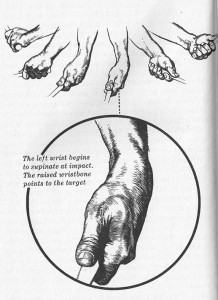There was a time not too long ago that my driver was my go-to club. I felt as good about hitting it into a narrow fairway as I did standing over a 6-inch putt on a slow green. But because of my health issues I haven’t played that much in the last five years and and I lost that swing.
So now I’m trying to simplify my swing to to make it easy to perform and easy to remember. Though I hit my irons okay, I hit one duck hook after another with my driver. The ball lands about 120 yards away then rolls into the left rough. You can’t play golf like that.
I changed my grip. That didn’t help. I change my takeaway. That didn’t help. I worked on my turn to square up the clubface. That didn’t help.
One of the things I had done to simplify my swing was to start the swing by pulling the club back with my right hand. I figured pulling something moves it more accurately than pushing it. So I pulled the club back with my right hand rather than pushing back with my left.
That, it turned out, was the problem. It was in the takeaway, but I had been looking in the wrong place.
Two days ago I decided to find out where in my swing my clubface was closing because that is what was causing those duck hooks. Every place I checked the clubface was closed. It got to the point where I saw my clubface had closed no more than two feet after it had been taken away from the ball. And then the solution hit me.
By pulling the club away with my right hand I was not allowing the club to rotate open. I was closing the club face from the very start. Try it and you’ll see what I mean.
So I tried doing the opposite and started the club back by gently pushing with my left hand. Problem solved.
The club face remained square and I began hitting drives just like I used to. Straight, up in air, and while maybe not as far as before, the ball still got out there.
I’m telling you this because sometimes it doesn’t take a wholesale change in your swing to correct the problem you’re having. If you just spend time investigating your swing in detail you can find out what the problem is. And if you don’t find it, keep looking.
I have always recommended lessons, but much more often you can figure out what the problem is and find the solution yourself. When your golf is based on knowledge that comes from you, that’s one step closer to owning your swing.

